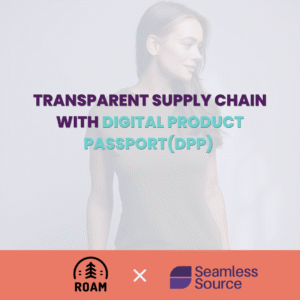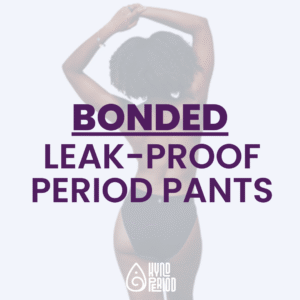Cotton is one of the most widely used fabrics – with 27 million tons of cotton being produced every single year. It is also the most valuable non-food agricultural product in the world.
Undoubtedly cotton is an extremely valuable commodity within many industries, including the fashion industry, and this is not expected to change any time soon. In this article, we explore the life cycle of cotton and the impacts that it has throughout the planet.

Overview of Cotton
Cotton is a fibre at the heart of the textile industry – and has many varieties including Egyptian cotton and Pima cotton depending on the species and where it originates from.
Cotton is a natural fabric made from the boll of the cotton plant (the fibres surrounding the seeds), it is produced with ‘staple’ fibres, which are turned into the fabric we know and love.
Cotton is used within clothing, soft furnishings, and a range of other products. It is the most popular fabric due to its low cost, versatility, comfort, and performance.
Cotton Types and Locations
Cotton is harvested all over the world – but there are 5 main countries that make up 75% of cotton production. According to Statista (2019/20), India is leading the production followed by China.
- India – 6.1 million tonnes
- China – 5.5 million tonnes
- US – 4.1 million tonnes
- Brazil – 1.9 million tonnes
- Pakistan – 1.7 million tonnes
Although the majority of cotton can be produced anywhere in the world due to technical enhancements, different cotton fabrics vary depending on their species and the location in which they originated. Fashion revolution states a massive 2.4% of the world is used to produce cotton (2021).
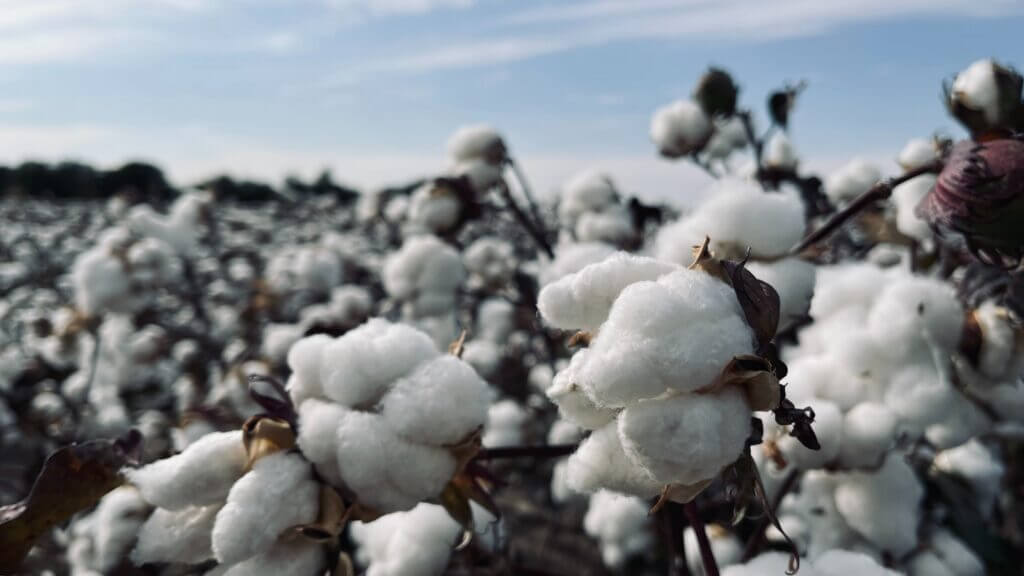
Upland cotton
Upland cotton comes from the cotton species Gossypium Hirsutum and can also be referred to as Mexican cotton.
This type of cotton makes up 90% of all cotton cultivation and production, and is most often found and harvested across Central America. It grows well in the majority of climates, and therefore can be produced worldwide.
Upland cotton ranges from short-to-medium length cotton fibres and is known for good quality everyday products. Upland cotton is perfect for bulk cotton fabric production due to its low cost compared to other species, yet it is usually not used for finer fabrics unless it is a specific type with a longer staple.
Acala cotton is a type of Upland cotton grown in the San Joaquin Valley Acala in California, and is among the highest quality Upland cottons – with a longer staple. However due to immigration requirements, Acala cotton is more expensive than other cottons made in America.
Is it likely that the majority of the cotton garments in your wardrobe are made or blended with Upland cotton of some variety.
Egyptian cotton
Egyptian cotton is a type of cotton originating from the species Gossypium Barbadense that grows along the river Nile in Egypt.
Egyptian cotton makes up less than 10% of all cotton production and despite the name, is widely produced in India and China today. Egypt is not even in the top 10 producers of Egyptian cotton in the world anymore – the title is more of a symbol of quality.
The Gossypium Barbadense that originates from Egypt has long-staple fibres due to the climate, and therefore makes much higher quality cotton than Upland cotton. Egyptian cotton is most frequently used within soft furnishings such as bedding, cushion covers or even bathrobes due to its soft, luxurious nature.
Egyptian cotton has a certain precedent, and therefore sometimes products are labelled as ‘Egyptian cotton’ even if the fabric is a low-quality blend in order to get consumers to purchase.
Pima cotton
Pima cotton is a variety of cotton that is also produced from the species Gossypium Barbadense (the same species as Egyptian cotton) and can also be referred to as Sea Island Cotton.
Pima cotton once again makes up less than 10% of all cotton production, and is most frequently produced in the US – however it originated in Peru and was cultivated in the US through the Pima Native American tribe, where it got its name.
Pima cotton is a type of extra-long-staple cotton, and is very smooth and resistant to rips, pilling, and fading. Due to its high-quality, Pima cotton is more expensive than Upland cotton.
Supima cotton is a type of Pima cotton that is grown in specific areas of the US, and makes up less than 1% of all cotton production in the world. In order to be considered Supima cotton, organic cultivation practices have to be abided by.
How is cotton fabric made?
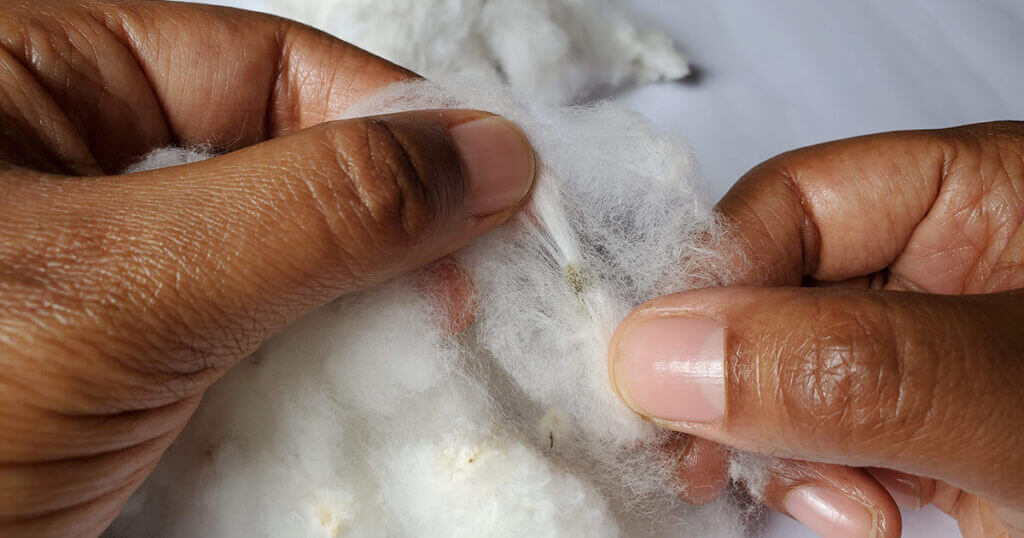
Cotton fabric starts at the cotton plant – once the plant matures and the flowers fall off, the seeds grow fibres that expand into the fluffy cotton boll that can be harvested.
Cotton bolls were picked and de-seeded by hand up until the invention of the cotton gin, and now the cotton fibres are harvested with cotton stripper machines and separated from the dirt and seeds within the cotton boll with automated circular saws in the gins.
Once the fibres are cleaned and separated, they can be formed into large bales that will eventually form the fabric. The bales are sent to textile production factories or mills where the raw fibres are cleaned and carded by machines.
The cleaned fibres are combed and formed into slivers – these slivers get twisted into what we know as yarns and can be turned into fabric through loom machines in the factories. Yarns can also be used in other ways, but for the purpose of bulk cotton fabric production, machine looming is the easiest way.
Once the fabric is made, it remains in its natural state until it is bleached or dyed in order for further use. ‘Greige’ cotton or unbleached cotton can be utilised by companies that want to dye their own fabric for production, and can be a way to save on costs for start-ups or SME’s, as well as helping with sustainability, as there is less waste this way.
The cotton fabric, once treated with the necessary chemicals and dyed, is then ready for purchase and distribution in order to be turned into a variety of cotton garments.
Cotton can also be treated with a range of finishes to make it more adaptable, such as weatherproofing.
Cotton fabric properties
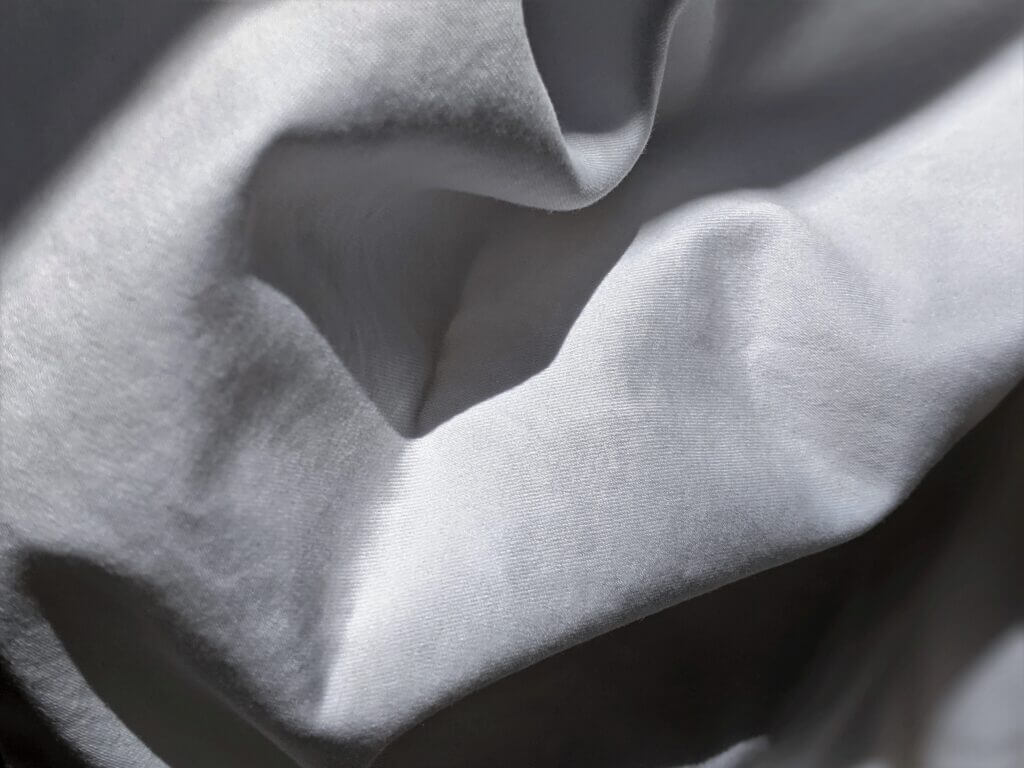
Finished cotton fabric is widely used throughout the fashion industry. There are a multitude of reasons for this – ranging from cost to certain properties that the fabric has. The properties of cotton fabric are extensive and include:
Softness
Due to the nature of cotton fibres – cotton is extremely soft, and even more so when high-quality cotton such as Egyptian and Pima cotton are used due to their longer staple length.
Cotton is often used within soft-furnishings and clothing that lies close to your skin such as bedding and under-garments for this reason – as it provides comfort. Cotton is also reportedly hypoallergenic and rarely causes allergic reactions.
Breathability
Cotton is 100% natural fibre which means that it is much more breathable than synthetic fabric alternatives. Natural fabrics allow your skin to breathe when worn, unlike synthetic fabrics that usually make you sweat much more.
Cotton is therefore good for cooler climates as it can trap heat in as well as hot temperatures as air is able to pass through it freely.
Durability
Cotton is strong and usually very wear-resistant – cotton has a high tensile strength, making it durable and less likely to rip or tear. Cotton fabric is also 30 percent stronger when wet, which means that it can withstand hot water whilst being washed.
Absorbency
Cotton fabric is very absorbent and has a large capacity for retaining water – cotton fabric can reportedly absorb up to 27 times its weight in water, and can absorb up to 5 times its weight before starting to feel damp.
This is because cotton transmits moisture away from the body – removing liquid from the skin, and is the reason it is frequently used for towels.
Colour-fastness
Cotton retains dye extremely well – due to being so absorbent the fabric is able to soak up dye and retain it much easier than synthetic fabrics.
Upkeep
Cotton is a natural fabric and it therefore a bit more tricky to care for than synthetic fabrics. Some issues include the fact that cotton fabrics are prone to shrinking, meaning that they should always be air-dried flat.
Cotton is also prone to creasing – and therefore should be ironed in order to keep it looking new and fresh.
Cotton fabric products
Cotton fabric is used widely within many industries and therefore can be found in a whole range of products.
According to Cotton Inc, 60% of women’s clothing items contain cotton fibers with 40% being made from all cotton. 75% percent of men’s clothing contains some kind of cotton blend and 85% is made from 100% cotton.
Jeans
Probably the most popular product made from 100% cotton are jeans. Jeans are a staple in many people’s wardrobes, and whilst some variations of jeans are blended with fabrics such as elastane to add stretch, standard jeans are always made of 100% cotton.
Jeans are made using denim which is a durable, rugged cotton twill fabric. This makes them hard-wearing, yet also comfortable and warm – making jeans an extremely practical choice for everyday wear.
T-shirts
T-shirts are often made with cotton fabric as they are designed to be soft, comfortable and worn close to the skin, in fact most t-shirts will be either 100% cotton or a blend of cotton fabric with a synthetic fabric such as polyester (poly-cotton).
Below you can see the journey that a standard 100% cotton t-shirt will go on throughout its lifecycle.
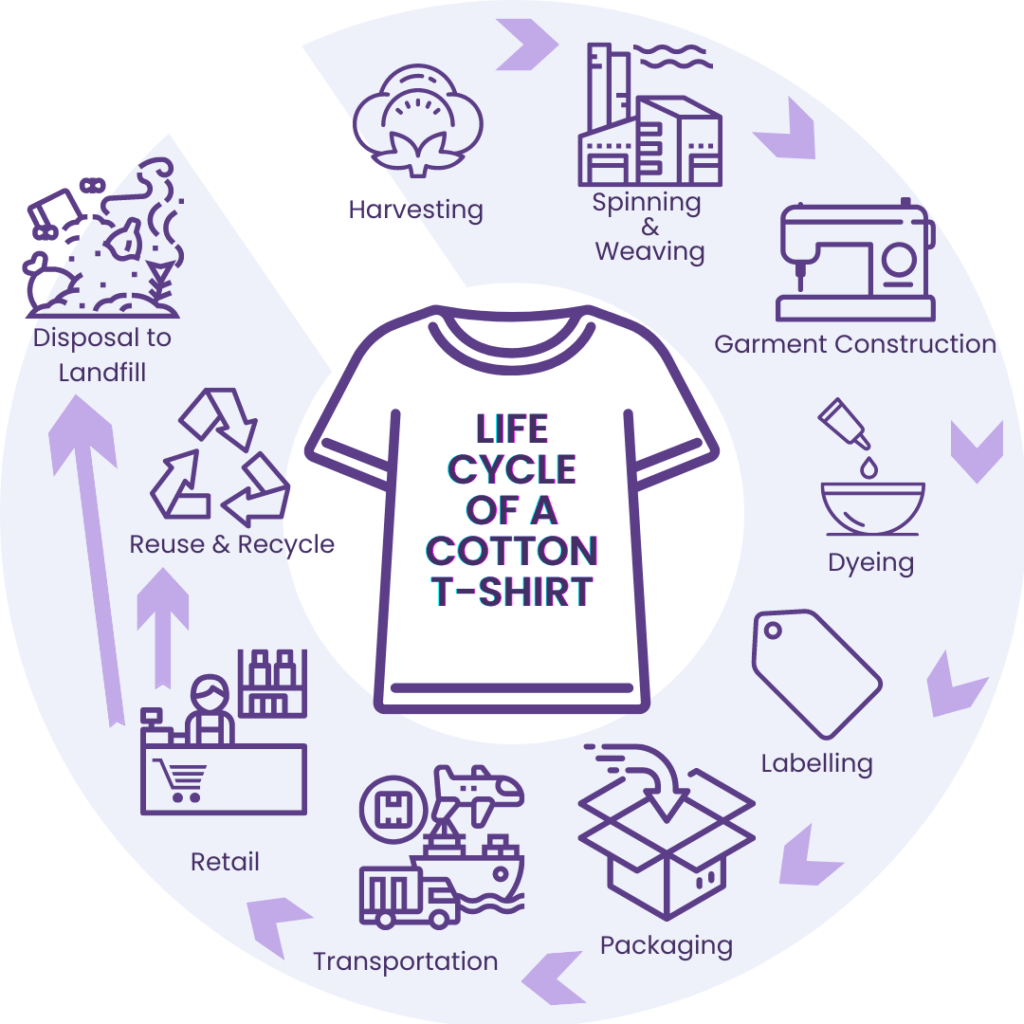
Dresses
Dresses are often made from cotton – because of cotton’s breathability and absorbency, it makes the fabric perfect for dresses as they are worn frequently in the summer, but can also be transitioned to winter-wear as the cotton fabric allows heat to be trapped.
Cotton is a great fabric for draping, and this lends well to a range of dress silhouettes.
Underwear
Cotton is a great choice for underwear for individuals who value comfort. As cotton is very breathable, it is a perfect fabric for garments that lie right next to the skin and helps to prevent infection and itching (as cotton is said to be hypoallergenic).
Bedsheets and towels
Cotton is frequently used within bedding and towels due to its absorbency and breathability.
Specific types of cotton such as Egyptian cotton and Pima cotton are frequently used for these types of textiles as they are designed to be extremely soft.
Medical supplies
Short-staple cotton (lower-quality cotton) can be used for medical supplies such as bandages and gauze due to its fluffy nature.
Conventional, organic and better cotton
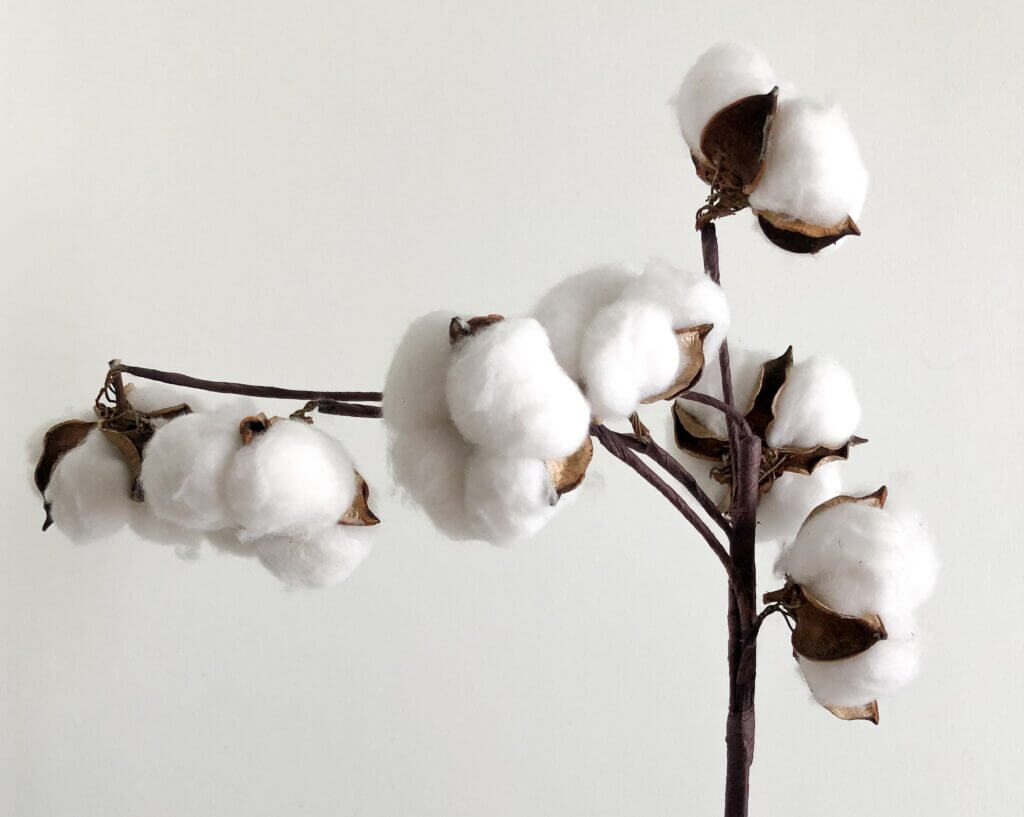
Conventional cotton
The majority of cotton in the world is conventional cotton – this covers the different types of cotton such as Upland or Egyptian cottons as they are farmed and produced in similar ways.
Cotton has received the title of ‘dirtiest crop in the world’ and conventional cotton farming has raised serious issues for health and the environment over recent years. This comes from the fact that 2.4% of the world is used for farming cotton and a tremendous 16% of insecticides and 7% of herbicides are used for farming alone – more than any other crop.
These pesticides contaminate the soil, air, and water and cause the deaths of millions of animals. Conventional cotton also uses many chemicals – including Aldicarb which is a powerful nerve agent and Endosulfan which is linked to comas, seizures, and even death.
Around 300 million people work in the cotton sector as a whole – the majority of cotton workers live in developing countries, work extremely long hours, are exposed to poisonous substances daily whilst only earning the bare minimum in wages.
Conventional cotton has a very harsh truth, and whilst it is a natural fibre, it does not mean that it is inherently good. If you have bought your cotton garments from a place where the price seems too good to be true, it usually is because it is.
Organic cotton
Organic cotton is an alternative option, as it does not have as many negative impacts as conventional cotton. Organic cotton creates fewer greenhouse gas emissions – with 46% less CO2 produced compared to conventional cotton.
Organic cotton also does not use the harmful chemicals in its growing stage that conventional cotton does, only natural fertilisers are used enhanced by crop rotation, which ensures the environment around us does not get contaminated from its production.
Organic cotton is a much better option than conventional cotton for the environment, animals and people’s health. Organic cotton is usually identifiable through the care label or tag on new garments, and is usually a more expensive option than conventional cotton – however one that is very worthwhile to switch to.
Better cotton
Better cotton or BCI (Better Cotton Initiative) cotton is a cultivation method for cotton. Having the BCI label on garments is reflective of the standard of farming and production of the cotton fabric itself.
Better cotton is described as ‘less bad, for having a certification of minimum conditions, such as not working in degrading conditions, as well as using protective equipment, but still with production practices of an industrial model’ (Moraes, Textile Exchange).
Better cotton still uses chemicals for the growth of the cotton plant – although not as many as conventional cotton, but instead focuses more on working conditions and pay, often supporting smaller communities and farmers of cotton to make it a more fair industry to work in.
Better cotton also aims to reduce water wastage and gas emissions, in order to create a more sustainable product than conventional cotton. More than 2 million farmers have the right to sell their cotton as Better cotton today, improving their quality of life and work.
The BCI label can be found on garments just like organic cotton.
Sustainability
The cotton plant itself is very non-harmful to the environment as it is a naturally existing product. Compared to synthetic fabrics such as nylon that is made from fossil fuels that are turned into plastic, and polyester that will never biodegrade, cotton seems like a very environmentally friendly option.
However, the mass-production and manufacturing process of cotton has led to issues with sustainability.
Water
One of the biggest implications of cotton is its water wastage. It takes more than 10 tons of water to produce enough cotton for 1 pair of jeans – this is a huge amount of water for a developing country (where the majority of cotton is produced).
One conventional cotton t-shirt takes around 2,700 liters of water to make. This has had a massive impact all over the world, and one of the most devastating effects of the cotton industry is the shrinking of the Aral Sea – which was once the 4th largest lake in the world.
Conventional cotton production also contaminates water systems, with toxic runoff making it unsafe to drink from many reservoirs and rivers.
Farming
Cotton cultivation is usually focused on making the largest amount of fiber possible at the lowest cost, which means that sometimes farmers do not properly care for the land they use. This can result in depletion of the soil in areas where it is grown.
Organic farming practices combat this through crop rotation, however this is few and far between and therefore the majority of cotton farming is inherently negative.
Ethicality
Unfortunately, cotton disadvantages do not end with environmental issues. Cotton has a well-known history of human exploitation. Despite it being 2021, cotton production is still associated with modern slavery, which is why Better cotton alternatives are so important.
Cotton production has been known to be engaged with child labor – with an extimated 450,000 kids being forced to work in the cotton production process in India alone. Many other countries such as China, the USA, Turkey, Pakistan and Uzbekistan are also associated with child labour practices.
Lifecycle
The majority of clothing in the 21st century is frequently thrown away, with a fast-fashion consumer mindset making trends die as quickly as they start. Cotton fabric can decompose within 5 months, making it one of the better materials out there.
However, in landfill, even decomposable fabrics can not always break down due to the garments being packed in so tightly. Instead, a positive for cotton is that it can be recycled with other fabrics.
Cotton can be recycled in both pre-consumer (material scraps) and post-consumer (garments) states, although it is easier to be recycled from pre-consumer sources.
Recycled cotton will never be as good quality as it was beforehand, as the fibres break and get shorted, reducing softness. Cotton also cannot be continuously recycled, as it needs to be blended in order to retain durability.
Cotton will always be one of the most important fabrics on the market, and will be found in almost every shop you set foot in whilst looking for clothes. We can only hope that as a society, we start the switch to a better cotton industry.
A few brands you can check out with good cotton initiatives include:
- Patagonia
- Boden
- People Tree
- Levi’s
- Girlfriend Collective
- Kotn
- Tentree
If you would like to learn more about the fashion industry or read upcoming articles about a range of other fabrics, our Seamless Source blog page is the perfect place for you!


